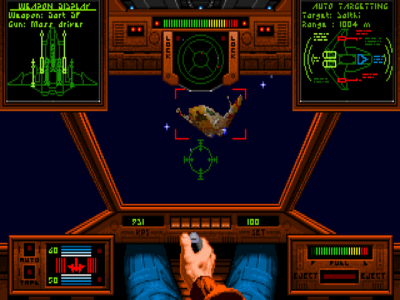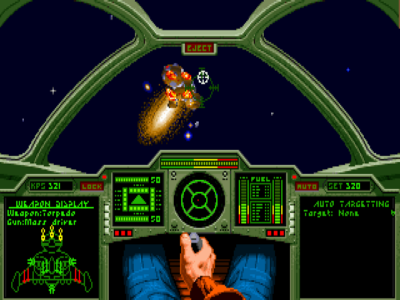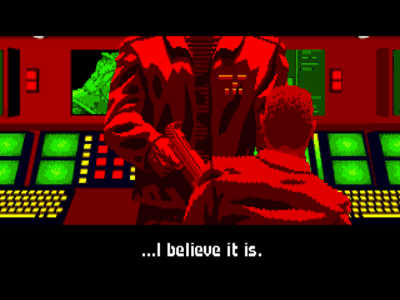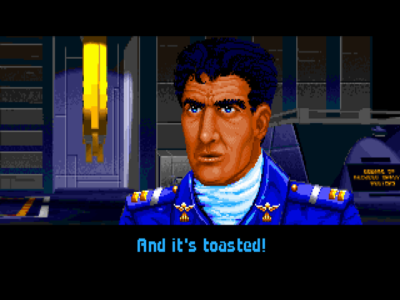
Wing Commander 1 and 2
Written by: Rik
Date posted: April 18, 2005
- Genre: Simulation
- Developed by: Origin Systems
- Published by: Electronic Arts
- Year released: 1990-91
- Our score: 4
About a month ago, I decided that the relatively short article of praise I wrote about a couple of the later Wing Commander games didn’t represent sufficient recognition of the series as whole and vowed to put things right, by reviewing the others and adding a few supplementary bits here and there. In actual fact, I went a bit Wing Commander crazy, ripping videos from WC 3&4, staying up all night reminding myself of Prophecy, and even splashing out on the Wing Commander movie on DVD. The last part of the task involved revisiting the original pre-movie days of WC, and to be honest, having spent recent evenings shooting at blocky, flat ships lurching around in a window on my desktop, I’ve started to get a bit fed up with it all.
Anything in the name of FFG, though, especially when wrongs have to be righted: my glib dismissal of the merits of these two titles a few years ago was made with misguided confidence that the chances of people playing them again on modern PCs would be minimal, based on my own struggles with Wing Commander 2 running too quickly on my 486. Speaking of which, a combination of the absurd speed at which the game ran and my own incompetence meant I never really made it past the first few missions, and so enabled a few cheats in order to enjoy the rest of the storyline. And as for the original, I have to be honest and say that until a few weeks ago I hadn’t even played it. Luckily, we now live in the age of DOSBox (something no lover of oldies should be without incidentally) and I’ve been able to put things right. Hurrah!
Wing Commander is, of course, the archetypal mission-based space shooter, to which all that followed owe a great deal. Its central assumption was simple: people liked the WWII-in-space battles from Star Wars and would jump at the opportunity to play the part of one of the pilots, especially if they happened to win a mighty victory for their side by blowing up an important battlestation at the end. LucasArts would later offer the chance to do it all in officially-licensed ships and surroundings, but while the X-Wing games were undoubtedly a success (and deservedly so), by the time the original was ready for release, Wing Commander had a legacy all of its own, thanks in no small part to the cinematic style the games adopted. Not only did you get to go to briefings and receive mission-based instructions, but you could also chat to fellow pilots and view animated cut-scenes depicting the progress of the war. It also happened to look and sound fantastic, and the high production values now commonplace in gaming were arguably witnessed for the first time here. It was the kind of game which made people want to upgrade their PCs, or in my case, wish that my Dad had bought an Amiga instead of an Atari ST.
The first point to note about Wing Commander is perhaps that it is first and foremost a game, with the cut-scenes nothing but a brief interlude between missions. It may come as a surprise to those steeped in the movie-style tradition which followed, but in the first WC game there is no lengthy introduction and no scene-setting, just a vague statement about a deadly war in the future. During the game, you can go to the bar and chat to the bartender and a couple of pilots before each mission, but at this stage it’s really a case of the cut-scenes serving the combat. For example, your wingmen all have their own personalities which affect how they fly – you can pick up a few hints about this from talking to them and they also occasionally give you combat tips, too. The bartender talks mainly about the progress of the war, so this is a good indication of how well you’re doing in the game if you hadn’t guessed already.

If you don’t notice that all the ships handle differently, you should at least appreciate the varied cockpit arrangements.
Everything else is all about the task at hand, with the captain asking for a report after each mission and praising/bollocking you accordingly. With no complex story to work around, you can be awarded medals or even a promotion for good in-game performance, a nice touch lost in later games. The only other story features are brief scenes of ground battles having been won or lost according to how well you’ve performed in the missions so far. The Kilrathi aren’t even that prominent – you’ll see more of them during combat communications than anywhere else – and those expecting to see Admiral Tolwyn somewhere along the line will also be disappointed. While gamers may have been impressed by the production values and the cut-scenes, they really only represented a small piece of the package, complementing the new gameplay elements Wing Commander brought such as the ability to communicate with other allied and enemy ships, check their status and alter their behaviour, or being able to take different mission paths to the end depending on performance. Okay, so we now take all of this for granted, but back in 1990 it was a really big deal.
Wing Commander 2 (subtitle: Vengeance of the Kilrathi) was really the genesis of the movie-style approach for which the series became famous. The game’s introduction bears all the hallmarks of a Hollywood film, as Chris Roberts’ name is announced in the manner of a film director, and the details of your character’s fall from grace is outlined. Owing to your achievements in the first game, you’ve risen up the ranks to become a respected pilot. During a mission deep in Kilrathi territory however, your carrier is attacked and destroyed by stealth fighters and you are blamed by Admiral Tolwyn, who brands you a traitor and banishes you to some bleak outpost to serve out the rest of your days. A chance encounter brings you back alongside old colleagues, but with the defeat at K’Tithrak Mang hanging over your head.
It’s pretty good stuff, with the theme of possible human treachery running throughout the story and your name constantly being dragged through the mud. The player character, previously restricted to ‘Yes, sir’ and other mission related details, is now a fully-developed character, taking a full part in the cut-scenes and acting according to the ‘heroic, flawed, slightly hot-headed’ stereotype often seen in films. Moreover, the whole presentation is now similar to a movie, with multiple locations, cut-scenes taking place in the cockpit, and more scripted events. The Kilrathi now feature in cut-scenes too, with the Emperor and Prince Thrakhath occasionally popping up to discuss the war effort. Generally, the feeling is of watching an animated film, albeit one in which the main characters all remain rooted to the spot (you never see any body parts move except the lips). While the game engine has undergone a few superficial changes, it’s obvious energies have been focused more on the storyline. Even the mission branching has been simplified to accommodate the cut-scenes – apparently it was felt that successful players missed out on a lot of the content in the first game and hence a lot of effort had been wasted.
All of this is very well and good, but are these oldies worth playing any more? Personally, I’d have to say not, for a number of reasons. I’ve already alluded to the dated graphics: for reasons of speed and detail, Origin decided to use flat, 2D sprites instead of polygons in these games, and it has to be said they look rather silly now. The enemy fighters aren’t so bad, but for some reason your own craft aren’t rendered so well, and the capital ships look ridiculous, getting pixellated every time you get up close and request permission to land. Leaving aesthetics aside, the combat isn’t really much fun – there always seems to be a delay when firing your guns and the constant dogfighting is neither fast-paced or sophisticated. WC detractors have often claimed the missions are too repetitive to be entertaining, a point which occasionally resonates when you’re sent out on yet another patrol, sweeping the waypoints clear of enemies and then returning to base. All-in-all, they feel like very old games (which of course they are) and you can’t help wondering whether you should at least fire up something a bit more recent if you really must spend your evening fighting fake space battles while hunched over a computer keyboard.
On a more positive note, it should be pointed out that criticism of these games’ graphics only refers to the combat environment. Stylistically, the cut-scene graphics, ship, uniform and cockpit designs are all well drawn, and have a certain ‘retro’ feel to them which is really quite appealing. While Star Wars is an obvious reference point, the developers were certainly also influenced by Battlestar Galactica, and there’s a definite late 70s/early 80s sheen to the whole experience. And while many of the sound effects are pretty puny, some of the music is quite stirring, with the little ditty which plays as pilots run to their ships particularly catchy.
As always with the Wing Commander series, storyline will play some part in how entertaining you find these games. The story for WC2 is pretty compelling: if you can tolerate the sluggish combat, you’ll certainly be drawn in by a desire to view the next cut-scene, or to see if there are any major plot developments if you just play one more mission. Wing Commander, on the other hand, doesn’t really offer that much in the way of plot, and once curiosity has been satisfied you’ll find the chit-chat in the bar is scant reward for the time you just spent in the cockpit. The Secret Missions add-on disks may be of more interest, representing a midway point story-wise between the two games, and setting the scene for the second by introducing characters who feature heavily in WC2. The missions are pretty tough however, and while there is more of an attempt at narrative, it’s essentially the same bar-briefing-blasting stuff.
There are a few reasons why you might want to spend some time with the early WC games in this day and age. If you’re a WC fan of old and feel like a nostalgia trip, then an extra chunk of enjoyment comes with remembering days of old and seeing if you’re as good at the combat as you used to be. For those who enjoyed the later FMV-laden extravaganzas but never got a chance to look at these games first time around, then curiosity can be satisfied and a bit of WC history learned. There’s not really enough here to recommend them to anyone else, however. Although the WC2 story is excellent, to see it all you have to plough through the missions, which don’t really cut the mustard any more. Meanwhile the first game doesn’t even have the saving grace of entertaining extended cut-scenes. A little harsh, maybe, but ultimately these games should be admired for their significance rather than entertainment value.





 Posts
Posts